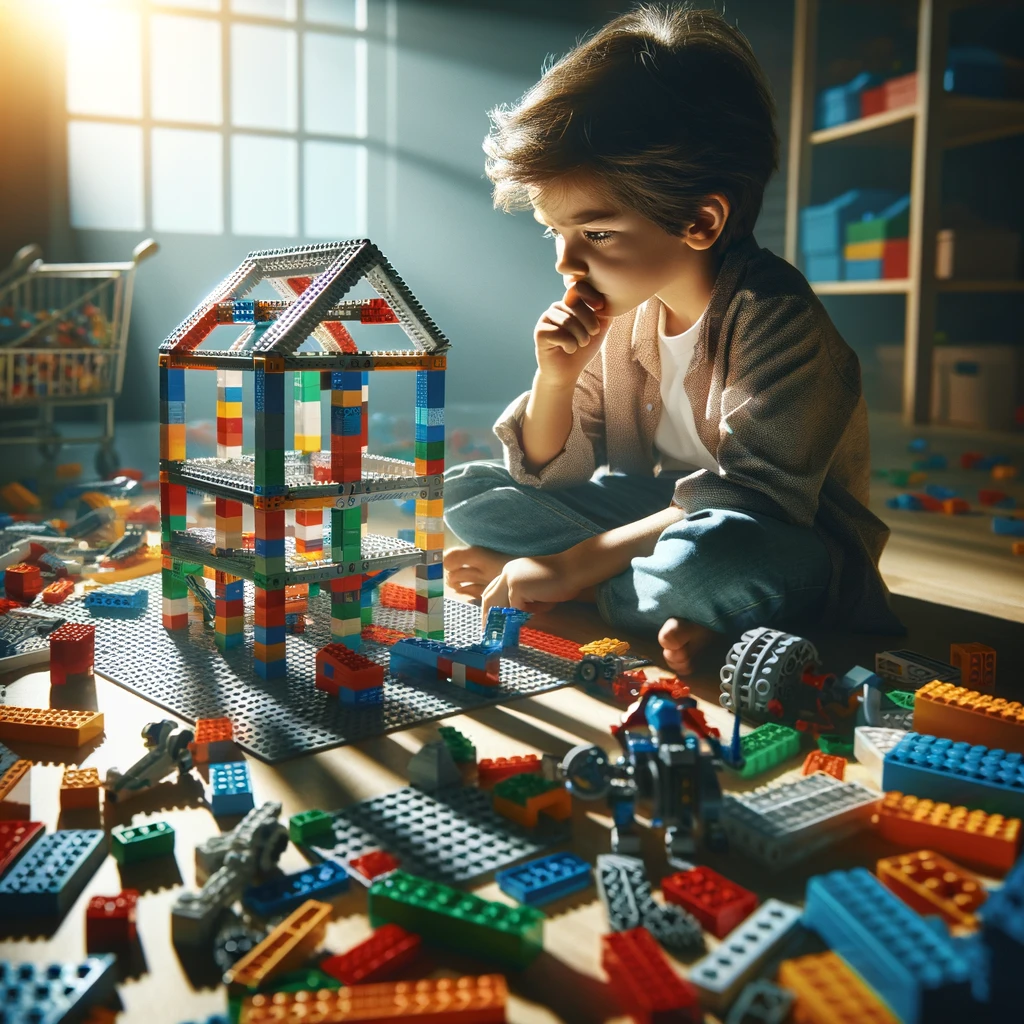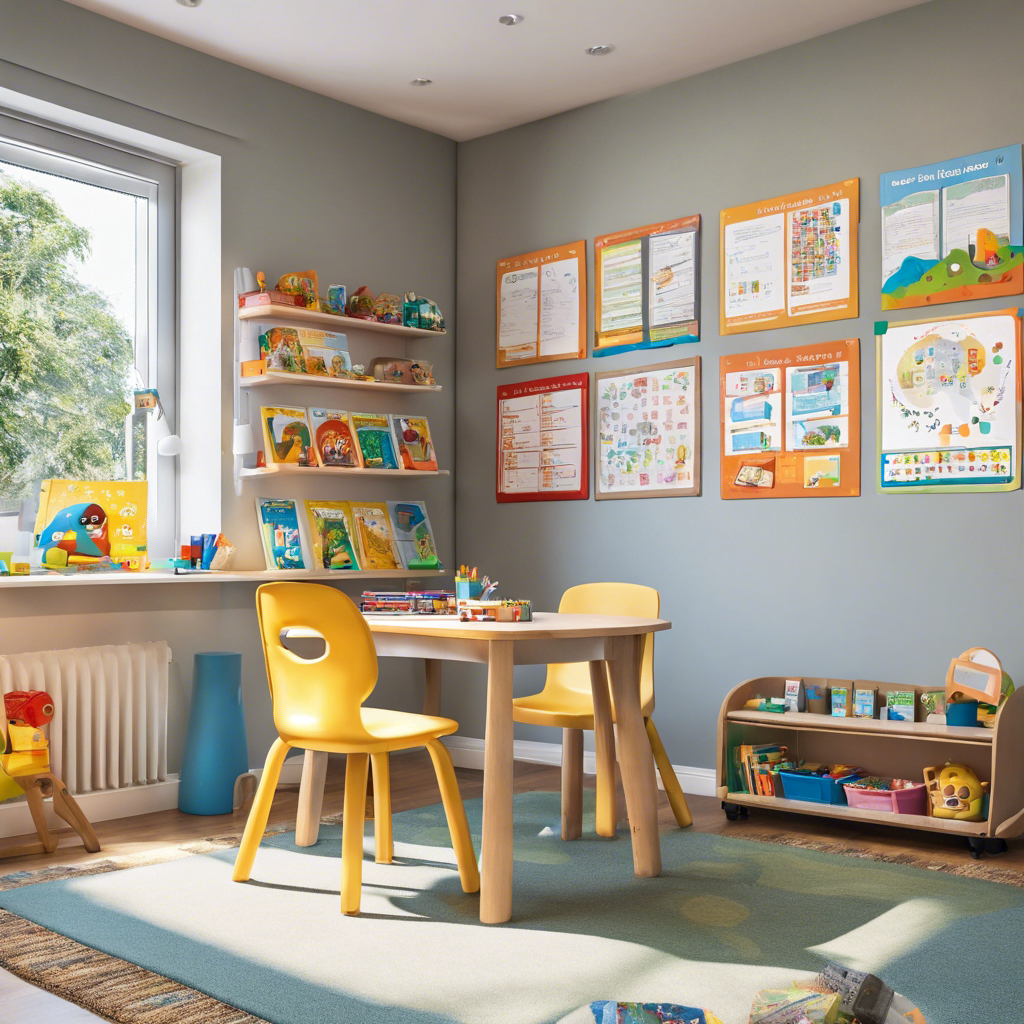Every Child’s a Natural Learner: A Mom’s Guide to Fostering Curiosity and Exploration at Home
As moms, we’ve all had those heart-melting moments—watching our little ones marvel at a crawling ladybug or build towering structures from blocks that seem to challenge the laws of physics. These instances of pure wonder and exploration offer us a window into the incredible learning journey our children embark on from their earliest days. It’s a journey driven by an innate curiosity and a desire to make sense of the world around them. Every chuckle, every wide-eyed gaze, and every determined reach is a testament to their built-in ability to learn, adapt, and grow.
In our role as nurturers of these young minds, we hold the key to encouraging this curiosity, fostering a deep-seated love for learning that transcends the traditional confines of education. Early childhood education is more than just the acquisition of knowledge; it’s about setting the stage for a lifetime of discovery, emotional and social growth, and self-awareness. This guide is dedicated to unveiling practical, mom-approved strategies to create an enriching learning environment right in the comfort of our homes. Together, we’ll celebrate the transformative power of play-based learning and the unparalleled joy of embarking on this educational journey side by side with our children.
Before we dive into the heart of creating a vibrant learning atmosphere at home, let’s align on some fundamental truths that will guide our exploration of early childhood education:
Children Are Born Ready to Learn
From their very first breath, our babies are on a mission to absorb everything the world has to offer. Their innate curiosity propels them to explore, experiment, and piece together the vast puzzle of their environment.
Learning is a Social Process
The interactions our children have with us, their siblings, and their peers are more than just playtime—they’re the building blocks of development. Through these social exchanges, they hone their communication skills, emotional intelligence, and sense of community.
Play is Essential for Learning
Playtime is far from frivolous; it’s the foundation of childhood learning. Through the magic of play—be it pretend, exploratory, or imaginative—our kids develop critical thinking, unleash their creativity, and master social nuances.
Language is the Foundation of Learning
Creating a language-rich environment is crucial for cognitive growth. Engaging in conversations, immersing them in stories, and filling their days with songs and rhymes enrich their vocabulary, enhance comprehension, and foster effective communication skills.
Children Learn Through Their Senses
Our children’s understanding of the world is sculpted through their senses. Sensory play, which engages touch, taste, smell, sight, and sound, is not just enjoyable—it’s essential for brain development and learning.
As we venture further into creating a nurturing learning environment at home, remember that our approach is rooted in these core principles. By embracing our children’s natural curiosity and learning styles, and by integrating educational activities into our daily routines, we lay the groundwork for a lifetime of curiosity, resilience, and joy in discovery. Let’s embark on this journey together, celebrating each step of our children’s learning adventure and the unique role we play in shaping their futures.
Crafting a Cozy Corner for Curiosity: Your Home as a Learning Haven
Transforming our homes into nurturing spaces for our kids’ endless curiosity doesn’t mean we need fancy equipment or a designated classroom. It’s all about creating a little nook where magic happens, where questions bloom like flowers, and where every discovery is a treasure. Let’s chat about how you can sprinkle a bit of this magic into your own home, making it the perfect backdrop for your child’s learning adventures.
Carving Out a Special Spot for Discovery
Imagine a cozy corner that whispers to your child, “This is your space to explore, learn, and dream.” It doesn’t have to be big or flashy. A simple, quiet spot where the world’s wonders can unfold will do just fine. Here’s how to make it happen:
Keep It Simple and Tidy
A cluttered space can be overwhelming for little ones (and let’s be honest, for us too). A few carefully chosen items are all you need to spark curiosity. Think of it as curating a mini-museum for their explorations. Rotating toys and books keeps the space fresh and exciting without cluttering it up.
Cozy Is the Name of the Game
Whether it’s a tiny table and chairs, a soft rug with fluffy pillows, or a snug beanbag, comfort invites your child to settle in and get lost in learning. A space that feels good is a space where they’ll want to spend time, whether they’re reading, crafting, or pondering the mysteries of the universe.
Decorate with Dreams in Mind
Fill the nook with things that light up your child’s imagination. A colorful alphabet chart, a map sprinkled with adventure, or their own masterpieces pinned up for all to see. These aren’t just decorations; they’re conversation starters, imagination sparkers, and learning tools all rolled into one.
Let There Be Light
Good lighting is like a warm hug for focus and concentration. Natural light is wonderful for this, so if you can, position their learning spot by a window. If that’s not an option, make sure the area is well-lit with soft, inviting light that makes everything clear and welcoming.
Creating this special learning spot at home is about sending a message to your child: learning is an adventure, and it’s one we value and celebrate in our family. It’s about making a space that’s as inviting as a hug, where curiosity is the guest of honor, and every question is a golden opportunity. As we journey together through the ups and downs of nurturing our little ones’ love for learning, remember, the most important lessons are often taught in the heart of our homes, amidst the laughter, the play, and the everyday moments of wonder.
Nurturing Independence and Routine: A Mom’s Strategy for Home Learning
As we continue our journey to create a nurturing learning environment at home for our kids, let’s dive into the heart of establishing routines and fostering independence. These elements are like the secret ingredients in our favorite family recipe—they make all the difference in helping our little ones feel secure, focused, and ready to conquer the world of learning with confidence.
Crafting a Routine That Sparkles
Kids, much like us, thrive when they know what’s coming next. A predictable routine doesn’t just ease the daily transitions; it wraps our children in a cozy blanket of security, allowing them to focus on the joy of learning rather than the uncertainty of what’s to come.
Set a Sparkling Schedule
Carve out specific times for learning adventures throughout the day. Maybe it’s a cuddly storytime after breakfast, a creative play session post-lunch, or a calm coloring activity before the stars say hello. These scheduled moments become beacons of excitement and anticipation in their day.
Visual Schedules: A Picture-Perfect Plan
For the little ones, a visual schedule with bright pictures or simple icons can be a game-changer. It’s like giving them a treasure map for the day, where X marks the spot for fun and learning. This not only helps them know what to expect but also gives them a sense of control over their day.
Embrace the Magic of Flexibility
While our routines are comforting, remember, the best adventures sometimes come from unexpected detours. Be open to following your child’s lead if they’re particularly engrossed in a project or suddenly curious about a new topic. These spontaneous learning moments are pure gold.
Fostering Independence: Let Them Lead the Way
As our children grow, encouraging them to spread their wings and explore on their own is crucial. This independence is the foundation upon which they build their confidence, creativity, and problem-solving skills.
Independent Play: The Realm of Imagination

Dedicate time each day for your child to dive into the world of independent play. This is their time to direct the play, make decisions, and explore at their own pace. It’s amazing what worlds they can create with just a little space and trust.
Challenge Them Just Right
Introduce activities that gently push their boundaries but are within their grasp to achieve. Whether it’s a puzzle that makes them think or a simple craft project that requires a bit of dexterity, these challenges help them grow and learn the joy of perseverance.
Applaud the Effort, Celebrate the Journey
In our home, we cheer on the trying, the effort, and the ‘having a go.’ It’s not about the perfect tower or the neatly colored page but the adventure in getting there. This mindset encourages our kids to embrace challenges and learn from every attempt.
Guide, Don’t Solve
When they hit a bump, resist the urge to smooth it out for them immediately. Instead, offer hints, ask leading questions, and encourage them to think of different ways they might overcome the obstacle. It’s about guiding them to find their solutions, not handing them ours.
Safe Spaces to Make Mistakes

Mistakes are not just allowed in our house; they’re celebrated as part of learning. Experiencing the consequences of their choices (within safe limits) teaches valuable lessons. Forgot the raincoat? A little rain never hurt anyone, and next time, they’ll remember.
By intertwining the consistency of routines with the empowerment of independence, we’re setting the stage for our children to not only learn but to thrive. They’ll know the comfort of predictability and the thrill of exploration, all within the loving bounds of home. Let’s continue to be the guiding light on their learning journey, celebrating each step, each question, and each discovery along the way.
Unlocking the Magic: A Guide to Your Child’s Learning Journey
As parents, we’re front-row spectators to the incredible growth spurt of learning and development that unfolds right before our eyes. From those first vocalizations to the moment they start arguing and asking “why?” about everything under the sun, our kids are on an epic quest for knowledge. This guide is here to walk alongside you, offering insights into the wondrous ways children learn and sharing tips on how to cultivate a home environment that’s ripe for discovery and growth.
The Serious Business of Play
Play might look like all fun and games, but beneath the surface, it’s a critical learning tool. It’s through play that our little ones master a whole host of essential skills:
- Problem-solving: Whether it’s figuring out how to build the tallest tower without it toppling over or navigating the social dynamics of sharing toys, play challenges kids to think critically and creatively.
- Creativity: Playtime is where children let their imaginations run wild. They invent new worlds, take on different roles, and explore endless possibilities, all of which fuel their creative fires.
- Social Skills: Interacting with others during play teaches valuable lessons in cooperation, communication, and empathy. It’s in these early interactions that the foundational blocks of social etiquette are laid.
A World of Sensory Exploration
For young explorers, the world is a sensory-rich playground. Engaging their senses fully is key to their learning:
- Touch: Activities that involve handling different materials help children grasp concepts like texture, weight, and size. Think play dough, sandboxes, or even a pile of autumn leaves.
- Taste: Exploring a variety of flavors can be both a culinary adventure and a learning experience, potentially paving the way for healthier eating habits.
- Smell: The scents that fill our world—from the smell of rain on the pavement to the aroma of freshly baked cookies—can trigger memories and learning.
- Sight: Bright colors, fascinating shapes, and the beauty of nature all captivate children’s attention, encouraging visual learning.
- Sound: The world is full of sounds to discover. From the melody of a favorite nursery rhyme to the rhythm of a drum, auditory experiences are everywhere.

Laying the Language Foundation
Language is the golden key to unlocking the world of learning and communication. Here’s how to enrich your child’s language development:
- Engage in Conversation: Talk with your child about everything and anything. Describe what you’re doing, share stories, and encourage them to express their thoughts and feelings.
- Read Together: Dive into the world of books. Reading not only introduces new vocabulary but also helps children understand narrative structure and the joy of storytelling.
- Sing and Rhyme: There’s something about the rhythm and melody of songs and rhymes that captivates children, making them an enjoyable way to learn language.
Creating a Home Learning Sanctuary
While the world is their classroom, having a special spot at home dedicated to learning can enhance your child’s focus and love for discovery.
- Choose a Spot: Find a quiet, well-lit corner of your home where your child can engage in focused activities without distractions.
- Make It Cozy: Comfortable seating and a welcoming atmosphere invite your child to spend time reading, drawing, or engaging in other learning activities.
- Inspire Curiosity: Decorate the space with interesting and educational visuals that spark questions and invite exploration.
Embracing the Rhythm of Routine
Predictable routines offer a comforting structure that helps children thrive, blending the excitement of learning with the security of knowing what comes next.
- Set a Schedule: Establish regular times for different activities, creating a rhythm to the day that balances play, learning, and rest.
- Build Confidence with Predictability: Knowing what to expect gives children the confidence to engage fully in each activity, making the most of every learning opportunity.
As we journey through the landscape of early childhood learning, remember that every moment of curiosity, every question, and every discovery is a step on the path to lifelong learning. In the next part of our guide, we’ll dive deeper into how to actively involve yourself in your child’s learning process and explore the diverse ways children absorb knowledge.
Navigating Educational Choices: Homeschooling vs Traditional Schooling and Beyond
As we guide our little ones on their educational journey, the path we choose plays a pivotal role in shaping their future. Let’s delve into the world of schooling options, weighing the pros and cons, and considering what’s best for our unique blossoms.
Traditional Schooling: A Classic Route
Traditional schooling, encompassing public, private, and charter schools, offers a structured approach with a set curriculum. It’s a world where kids learn the core subjects, guided by qualified teachers. Beyond academics, it’s a place for social butterflies to spread their wings, engaging in extracurriculars and forming lifelong friendships.
Homeschooling: Tailoring Education to Fit
Homeschooling is like crafting a bespoke suit for your child’s education. It’s hands-on, allowing us to tailor the learning experience to our child’s needs, interests, and pace. The flexibility in scheduling is a boon, letting us dive deep into subjects that spark joy. Yet, it’s a path that demands our time, energy, and creativity to ensure a well-rounded educational experience.
Choosing the Path Less Traveled (Or More)
Deciding between homeschooling and traditional schooling isn’t a decision to be taken lightly. It’s about finding the right fit for your child’s unique tapestry of needs and your family’s lifestyle. Consider these factors:
- Your Child’s Learning Style: Is your child a solo explorer or a group adventurer? Understanding their learning style is key.
- Family Lifestyle: Homeschooling is a commitment. Reflect on whether your family’s rhythm can harmonize with the demands of homeschooling.
- Educational Goals: What are your dreams for your child’s education? Whether it’s a rich academic foundation or a customized learning journey, your priorities will guide your choice.
Beyond Black and White: Other Educational Avenues
The educational landscape is vast and varied, offering more than just the choice between homeschooling and traditional schooling. Here are a few alternatives:
- Charter Schools: These innovative public schools offer creative curriculums, blending the best of both worlds.
- Enrichment Programs: Supplement your child’s education with programs that ignite their passions, be it in arts, languages, or STEM.
- Online Learning: The digital realm offers endless knowledge at our fingertips. It’s a flexible option but works best with a guiding hand from us.
Addressing the Elephant in the Room: Common Concerns
Every choice comes with its set of worries. Here’s how to tackle some common ones:
- Socialization in Homeschooling: Homeschooling doesn’t mean isolation. With co-ops, community activities, and sports, homeschooled kids can flourish socially.
- Academic Achievement: Research shows homeschooled kids often excel academically, thanks to personalized learning and dedicated parental involvement.
- College Prep: Homeschooled students navigate college admissions with portfolios and standardized tests, often bringing unique experiences that make them stand out.
Choosing the educational path for our children is one of the many hats we wear as parents. It’s about listening to our hearts, understanding our children, and making informed decisions that light up their paths to success. Whether it’s the structured world of traditional schooling or the customized journey of homeschooling, the goal remains the same: to nurture curious, confident, and compassionate learners ready to take on the world.
Building a Well-Rounded Learner: Activities and Resources
Embarking on the educational journey with our children is an adventure filled with discovery, growth, and the occasional mess in the kitchen. As we navigate this path, it’s essential to remember that learning extends far beyond the traditional classroom setting. It’s in the everyday moments, the spontaneous adventures, and the quiet afternoons spent curled up with a book that our children’s minds expand and flourish. Let’s dive into a world of activities and resources that can enrich your child’s learning experience right at home.
Everyday Adventures: Learning in the Flow of Life
The beauty of learning at home is that it can seamlessly integrate into our daily lives, turning ordinary moments into extraordinary learning opportunities. Here are a few ideas to get you started:
- Grocery Store Math: Who knew that a trip to the supermarket could be a math lesson in disguise? Engage your child in weighing fruits, comparing prices, or even budgeting for a special treat.
- Culinary Tales: The kitchen is not just for cooking; it’s a stage for storytelling. As you mix, measure, and bake, weave tales about the ingredients, where they come from, and how they transform into delicious dishes.
- Nature as a Classroom: A walk in the park can be a mini science expedition. Encourage your child to observe the ecosystem around them, collect leaves for a craft project, or simply marvel at the wonders of the natural world.
- Dance and Sing: Incorporate music and movement into your day. Sing songs that teach counting or the alphabet, and let loose with a dance party that gets those little bodies moving.
Beyond the Front Door: Enriching Experiences in the Community
While home is where the heart (and a lot of learning) is, venturing out can provide valuable experiences that enrich your child’s understanding of the world.
- Library Love: Libraries are magical places filled with stories waiting to be discovered. Regular visits can open the door to new interests and foster a lifelong love of reading.
- Museum Magic: Interactive exhibits at museums and science centers invite hands-on exploration and learning, making history, science, and art come alive.
- Community Connections: Look into programs at local community centers or parks. From art classes to sports teams, these activities offer both learning and social opportunities.
- Digital Discovery: The digital world offers a plethora of educational resources. From engaging apps to informative websites, there’s a wealth of knowledge at our fingertips. Just remember to navigate this space with care, ensuring content is age-appropriate and time online is balanced with offline activities.
Fostering a Love for Reading
At the heart of learning is the ability to read. It’s a skill that opens up worlds, sparks imagination, and lays the foundation for lifelong learning.
- Read Together Every Day: Make reading a cherished part of your routine. Explore different genres, use funny voices for characters, and engage with the story by asking questions.
- Create a Reading Sanctuary: Set up a special spot for reading adventures. Whether it’s a corner filled with pillows or a tent decked out with fairy lights, make it inviting and cozy.
- Be a Reading Role Model: Let your child see you reading. Share your excitement about books, discuss the stories you love, and create a family culture that celebrates reading.
- Library as a Second Home: Regular library visits can be exciting outings. Encourage your child to explore, join in on library events, and choose their own books to bring home.
Remember:
- Celebrate the Journey: Focus on the joy of learning, not just the achievements. Applaud effort, curiosity, and the willingness to try new things.
- Keep It Fun: Choose activities that light up your child’s eyes and match their interests. Learning should feel like an adventure, not a chore.
- Tailor to Your Child: Pay attention to your child’s developmental stage and interests. What captivates them? Use that as a springboard for learning.
By weaving these activities and resources into the fabric of your daily life, you’re not just teaching your child about the world; you’re showing them how to learn with joy, curiosity, and resilience. Here’s to the journey of building well-rounded learners, one playful adventure at a time.
Conclusion: Every Child’s Learning Journey is Unique
As we wrap up our exploration into creating a nurturing learning environment at home, it’s essential to remember that each child’s path to discovery and understanding is wonderfully unique. By tuning into the natural rhythms of how children learn, encouraging their innate curiosity, and shaping a supportive space, we lay down the groundwork for our little ones to grow into inquisitive, confident learners.
The journey of education is vast and varied, and there truly isn’t a one-size-fits-all map. The most fruitful educational path is tailored to fit the individual quirks, needs, and fascinations of your child. It’s about walking alongside them, hand in hand, reveling in the joy of new discoveries, applauding their milestones, and nurturing a deep-seated passion for learning. As parents, our role is to guide, support, and cheerlead, empowering our children to unfold into their fullest potential as eager, capable learners, ready to dive into the vast ocean of knowledge that awaits them.
This series on Childhood Education was crafted with love and hope – a hope that it serves as a beacon, illuminating practical insights and strategies to enrich your child’s educational voyage.
See Also:
- National Association for the Education of Young Children (NAEYC): https://www.naeyc.org/ This website is an excellent resource for parents and educators seeking information on high-quality early childhood education (birth through age 8). NAEYC is a professional organization with a strong reputation and provides research-based articles, practical tips, and a deep dive into child development milestones.
- Zero to Three: National Center for Infants, Toddlers and Families: https://www.zerotothree.org/ This website focuses specifically on the crucial early years (birth to 3) and offers resources, research, and practical guidance to support healthy development for infants, toddlers, and their families. Zero to Three is a trusted source for information on language development, social-emotional development, and strategies for fostering positive parent-child relationships.
- American Academy of Pediatrics (AAP): https://www.aap.org/ The AAP website is a comprehensive resource for parents on various childhood health topics, including all aspects of development. They offer information on language development milestones, tips for encouraging communication skills, and address common concerns parents may have about their child’s learning journey. The AAP website is a reliable source of evidence-based information presented in a clear and accessible way.

